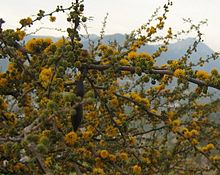Vachellia caven
| Roman cassie | |
|---|---|
 |
|
| Scientific classification | |
| Kingdom: | Plantae |
| (unranked): | Angiosperms |
| (unranked): | Eudicots |
| (unranked): | Rosids |
| Order: | Fabales |
| Family: | Fabaceae |
| Genus: | Vachellia |
| Species: | V. caven |
| Binomial name | |
|
Vachellia caven (Molina) Seigler & Ebinger |
|
| varieties | |
|
|
 |
|
| Range of Vachellia caven | |
| Synonyms | |
Vachellia caven (Roman Cassie, Aromita, Aromo Criollo, Caven, Churque, Churqui, Espinillo, Espinillo de Baado, Espino, Espino Maulino) is an ornamental tree in the Fabaceae family. Vachellia caven is native to Argentina, Bolivia, Chile, Paraguay, and Uruguay. It grows four to five metres tall and bears very stiff and sharp white thorns up to 2 cm in length. It blooms in Spring, with bright yellow flowers 1 cm to 2 cm in diameter.
Prominent occurrences of V. caven are within the Chilean matorral of central Chile, where the species is a common associate of the Chilean Wine Palm, Jubaea chilensis.
The flowers of V. caven are used as food for bees in the production of honey.
The tree is used for erosion control.
The tree has ornamental uses.
Tannin from the seed pods is used for tanning hides. The wood is used as fuel and to make posts for fences. The chief current human use for V. caven is in the production of charcoal.
The flowers are used in perfume.
...
Wikipedia
